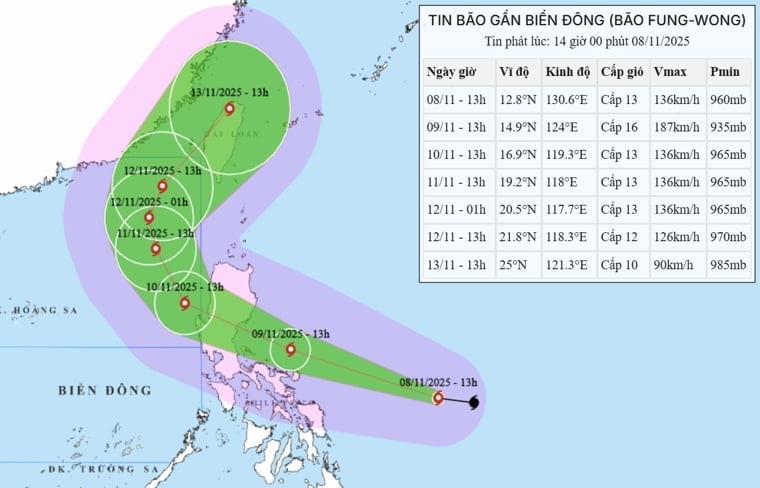On the afternoon of November 8, the National Center for Hydro-Meteorological Forecasting (Department of Hydro-Meteorology, Ministry of Agriculture and Environment ) issued a storm warning near the East Sea about storm Fung-Wong. Early in the afternoon of November 8, the storm was at level 13 (134-149km/h), gusting to level 16 and likely to strengthen to a super typhoon (level 16) tomorrow (November 9).
From tonight, the eastern sea area of the northern East Sea has strong northeast winds of level 6-7, gusting to level 8-9. From the night of November 9, the winds in this sea area will increase to level 8-9; the area near the storm center will have strong winds of level 10-12, gusting to level 14-15. Waves are 3-5m high, later increasing to 6-8m, the sea is very rough.

Forecast of the trajectory and intensity of typhoon Fung-Wong from the National Center for Hydro-Meteorological Forecasting. Photo: NCHMF .
Around the morning of November 10, the storm will enter the East Sea and become storm number 14 in 2025. At this time, the storm will decrease in intensity to level 13, gusting to level 16 and then move north. It is forecasted that during November 10-12, the sea area east of the northern East Sea will continue to have strong storm winds of level 11-13, gusting to level 16. Waves will be 8-10m high, with rough seas. All boats operating in the above-mentioned dangerous areas are likely to be affected by thunderstorms, strong whirlwinds, strong winds and big waves.
According to the National Center for Hydro-Meteorological Forecasting, it is now the end of the storm season and according to the usual rules, storms move west, even west-southwest and make landfall in the South Central provinces. However, storm Fung-Wong moved north and went out. This is the unusual point of this storm.
Explaining the cause, the Hydrometeorological Agency said: Currently, typhoon Fung-Wong is operating in a very favorable environment with high sea surface temperature (29-30 degrees Celsius), low vertical wind shear... so the storm's intensity will continue to increase and is likely to reach super typhoon level on November 9. When entering the sea area southeast of Luzon Island (Philippines), the environment is no longer favorable so the storm is likely to weaken in intensity.
By the time the storm entered the East Sea on the morning of November 10, the subtropical pressure branch in the north (which is the guiding current for the storm) had both weakened and expanded further south of the storm. Therefore, the storm tended to move more to the north. As it moved to higher latitudes, the storm would enter the guiding current of the upper westerly wind zone, so it was likely to change direction to the northeast and leave the East Sea.
The latest forecast shows that the storm will likely make landfall in Taiwan (China) around November 13.
Source: https://nongnghiepmoitruong.vn/du-bao-bao-so-14-khong-vao-viet-nam-d783151.html




![[Photo] Cutting hills to make way for people to travel on route 14E that suffered landslides](https://vphoto.vietnam.vn/thumb/1200x675/vietnam/resource/IMAGE/2025/11/08/1762599969318_ndo_br_thiet-ke-chua-co-ten-2025-11-08t154639923-png.webp)






























![[Video] Hue Monuments reopen to welcome visitors](https://vphoto.vietnam.vn/thumb/402x226/vietnam/resource/IMAGE/2025/11/05/1762301089171_dung01-05-43-09still013-jpg.webp)
































































Comment (0)